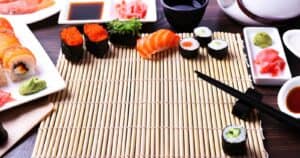Sushi lovers, have you ever wondered how your favorite little seaweed-wrapped bundles differ from their Korean cousin, kimbap? While these two iconic rice rolls share some common traits, they have key differences when it comes to origins, ingredients, seasoning, and presentation.
Sushi hails from Japan and features raw fish, seafood, and rice seasoned with vinegar. Kimbap is Korean and contains cooked fillings like meat, eggs, and veggies paired with sesame oil-infused rice. Sushi can be served as nigiri, sashimi, or cut rolls, while kimbap always comes as an uncut roll. Traditional dipping sauces also distinguish the two.
Want to become a sushi vs. kimbap expert? I’ll walk you through everything you need to know to tell your maki rolls apart. You’ll be a rice roll connoisseur in no time!
Stick around to master the details of these delectable Asian treats. You’ll gain a whole new appreciation for both sushi and kimbap when you understand the nuances that set them apart.
Sushi and Kimbap Origins
First, let’s look at where sushi and kimbap come from:
- Sushi originated in Japan, dating back to the 8th century AD. It was invented as a way to preserve raw fish by fermenting it in vinegared rice.
- Kimbap hails from Korea and is a more modern food, first appearing in the early-to-mid 1900s. It adapted sushi into a Korean style rice roll.
So while sushi has ancient roots as a preservation method, kimbap is a newer adaptation of the concept using Korean flavors.
Key Ingredients in Sushi vs. Kimbap
Sushi and kimbap also differ in terms of key ingredients used to make them:
Sushi Ingredients
- Sushi rice – white, short-grain rice seasoned with vinegar, sugar, and salt
- Raw seafood – tuna, salmon, yellowtail, shrimp, squid, etc.
- Vegetables – cucumbers, avocado, carrots, pickled daikon radish
- Nori – dried seaweed wrap
Kimbap Ingredients
- White rice – seasoned with sesame oil and salt
- Cooked meats – beef bulgogi, spam, luncheon meats
- Vegetables – carrots, spinach, pickled radish
- Nori – dried seaweed wrap
So sushi highlights raw fish and vinegared rice, while kimbap uses cooked meats and vegetable fillings.
Forms of Sushi vs. Kimbap
Sushi and kimbap also differ in terms of how they are shaped and served:
- Sushi comes in several styles:
- Nigiri – fish or seafood over pressed rice
- Sashimi – slices of raw fish without rice
- Maki – seaweed roll with fish and rice
- Kimbap is served only as maki – a seaweed roll cut into a cylinder.
Additionally, sushi maki rolls are cut into bite-sized wheels, while kimbap rolls stay in long cylinders.
Seasoning and Dipping Sauces
Traditional dipping sauces also distinguish sushi from kimbap:
- Sushi – soy sauce, wasabi, and pickled ginger
- Kimbap – gochujang (red chili paste), ranch dressing, or no sauce
The vibrant green wasabi and pickled ginger are hallmarks of authentic sushi. Kimbap features Korean flavors like gochujang and occasionally ranch dressing.
Nutrition Comparison
Lastly, let’s look at overall nutrition profiles:
- Sushi is lower in calories and carbs thanks to the vinegar rice. It provides high-quality protein from fish.
- Kimbap often contains processed meats so can be higher in sodium. It has more carbs from untreated rice. Both provide fiber, vitamins, and minerals.
So sushi offers more protein, while kimbap may be higher in refined carbs and sodium. But both make tasty and nutritious options!
Make Your Own Sushi vs. Kimbap
Now that you understand the major differences between sushi and kimbap, why not try making them yourself at home?
Having homemade versions of both delicious rice rolls lets you customize them to your tastes. Here are some tips:
DIY Sushi
- Use short-grain Japanese rice seasoned with rice vinegar.
- Stick with raw tuna, salmon, shrimp, cucumber and avocado to start.
- Roll tight but don’t smash rolls when cutting.
- Serve with soy sauce, wasabi, and pickled ginger.
DIY Kimbap
- Season rice with toasted sesame oil and salt.
- Try pork belly, chicken, ham, carrots, spinach, and pickled radish.
- Roll up tight in a bamboo mat lined with plastic wrap.
- Slice into 1-inch cylinders and serve with gochujang.
Making your own lets you fully appreciate the nuances of each style!
Sushi and Kimbap – Two Unique Rice Rolls
While sushi and kimbap may seem interchangeable at first glance, they have distinct origins, ingredients, forms, and flavor profiles.
Sushi highlights raw fish, vinegar-seasoned rice, and Japanese accents. Kimbap focuses on cooked meat and seasoned vegetables in the Korean style.
The next time you enjoy these rice rolls, you’ll be able to appreciate the many elements that set sushi and kimbap apart! Both offer delicious and healthy options for a light meal or snack.
So expand your palate and treat yourself to both types of rice rolls. My advice? Enjoy sushi with soy and kimbap with gochujang for an authentic flavor fusion!
Let me know if you have a favorite type of sushi or kimbap roll. I’m always hungry to discover new rice roll renditions!





